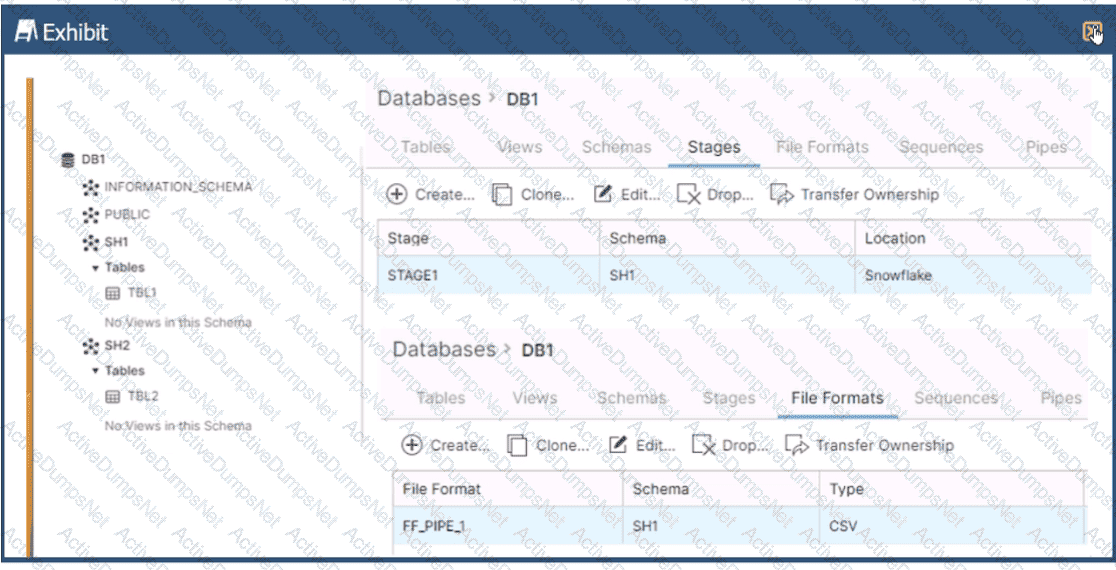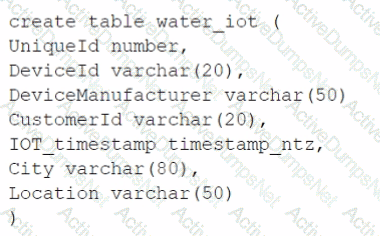Snowflake ARA-C01 SnowPro Advanced: Architect Certification Exam Exam Practice Test
SnowPro Advanced: Architect Certification Exam Questions and Answers
Which of the following are characteristics of how row access policies can be applied to external tables? (Choose three.)
The following table exists in the production database:
A regulatory requirement states that the company must mask the username for events that are older than six months based on the current date when the data is queried.
How can the requirement be met without duplicating the event data and making sure it is applied when creating views using the table or cloning the table?

Based on the architecture in the image, how can the data from DB1 be copied into TBL2? (Select TWO).
A)

B)

C)

D)

E)

An Architect has a design where files arrive every 10 minutes and are loaded into a primary database table using Snowpipe. A secondary database is refreshed every hour with the latest data from the primary database.
Based on this scenario, what Time Travel query options are available on the secondary database?
A new user user_01 is created within Snowflake. The following two commands are executed:
Command 1→ SHOW GRANTS TO USER user_01;
Command 2→ SHOW GRANTS ON USER user_01;
What inferences can be made about these commands?
When loading data into a table that captures the load time in a column with a default value of either CURRENT_TIME () or CURRENT_TIMESTAMP() what will occur?
The Business Intelligence team reports that when some team members run queries for their dashboards in parallel with others, the query response time is getting significantly slower What can a Snowflake Architect do to identify what is occurring and troubleshoot this issue?
A)

B)

C)

D)

A table for IOT devices that measures water usage is created. The table quickly becomes large and contains more than 2 billion rows.

The general query patterns for the table are:
1. DeviceId, lOT_timestamp and Customerld are frequently used in the filter predicate for the select statement
2. The columns City and DeviceManuf acturer are often retrieved
3. There is often a count on Uniqueld
Which field(s) should be used for the clustering key?
A Developer is having a performance issue with a Snowflake query. The query receives up to 10 different values for one parameter and then performs an aggregation over the majority of a fact table. It then
joins against a smaller dimension table. This parameter value is selected by the different query users when they execute it during business hours. Both the fact and dimension tables are loaded with new data in an overnight import process.
On a Small or Medium-sized virtual warehouse, the query performs slowly. Performance is acceptable on a size Large or bigger warehouse. However, there is no budget to increase costs. The Developer
needs a recommendation that does not increase compute costs to run this query.
What should the Architect recommend?
A company’s daily Snowflake workload consists of a huge number of concurrent queries triggered between 9pm and 11pm. At the individual level, these queries are smaller statements that get completed within a short time period.
What configuration can the company’s Architect implement to enhance the performance of this workload? (Choose two.)
A Snowflake Architect is setting up database replication to support a disaster recovery plan. The primary database has external tables.
How should the database be replicated?
How can the Snowpipe REST API be used to keep a log of data load history?
A Snowflake Architect is designing a multiple-account design strategy.
This strategy will be MOST cost-effective with which scenarios? (Select TWO).
Which Snowflake data modeling approach is designed for BI queries?
What are characteristics of Dynamic Data Masking? (Select TWO).
An Architect is implementing a CI/CD process. When attempting to clone a table from a production to a development environment, the cloning operation fails.
What could be causing this to happen?
What step will im the performance of queries executed against an external table?
An Architect entered the following commands in sequence:

USER1 cannot find the table.
Which of the following commands does the Architect need to run for USER1 to find the tables using the Principle of Least Privilege? (Choose two.)
How can the Snowflake context functions be used to help determine whether a user is authorized to see data that has column-level security enforced? (Select TWO).
An Architect uses COPY INTO with the ON_ERROR=SKIP_FILE option to bulk load CSV files into a table called TABLEA, using its table stage. One file named file5.csv fails to load. The Architect fixes the file and re-loads it to the stage with the exact same file name it had previously.
Which commands should the Architect use to load only file5.csv file from the stage? (Choose two.)
Which command will create a schema without Fail-safe and will restrict object owners from passing on access to other users?
An Architect with the ORGADMIN role wants to change a Snowflake account from an Enterprise edition to a Business Critical edition.
How should this be accomplished?
A retailer's enterprise data organization is exploring the use of Data Vault 2.0 to model its data lake solution. A Snowflake Architect has been asked to provide recommendations for using Data Vault 2.0 on Snowflake.
What should the Architect tell the data organization? (Select TWO).
An Architect would like to save quarter-end financial results for the previous six years.
Which Snowflake feature can the Architect use to accomplish this?
An Architect is designing a file ingestion recovery solution. The project will use an internal named stage for file storage. Currently, in the case of an ingestion failure, the Operations team must manually download the failed file and check for errors.
Which downloading method should the Architect recommend that requires the LEAST amount of operational overhead?
Which statements describe characteristics of the use of materialized views in Snowflake? (Choose two.)
What integration object should be used to place restrictions on where data may be exported?
A Data Engineer is designing a near real-time ingestion pipeline for a retail company to ingest event logs into Snowflake to derive insights. A Snowflake Architect is asked to define security best practices to configure access control privileges for the data load for auto-ingest to Snowpipe.
What are the MINIMUM object privileges required for the Snowpipe user to execute Snowpipe?
A company needs to have the following features available in its Snowflake account:
1. Support for Multi-Factor Authentication (MFA)
2. A minimum of 2 months of Time Travel availability
3. Database replication in between different regions
4. Native support for JDBC and ODBC
5. Customer-managed encryption keys using Tri-Secret Secure
6. Support for Payment Card Industry Data Security Standards (PCI DSS)
In order to provide all the listed services, what is the MINIMUM Snowflake edition that should be selected during account creation?
Which of the below commands will use warehouse credits?
A media company needs a data pipeline that will ingest customer review data into a Snowflake table, and apply some transformations. The company also needs to use Amazon Comprehend to do sentiment analysis and make the de-identified final data set available publicly for advertising companies who use different cloud providers in different regions.
The data pipeline needs to run continuously ang efficiently as new records arrive in the object storage leveraging event notifications. Also, the operational complexity, maintenance of the infrastructure, including platform upgrades and security, and the development effort should be minimal.
Which design will meet these requirements?
A company has an external vendor who puts data into Google Cloud Storage. The company's Snowflake account is set up in Azure.
What would be the MOST efficient way to load data from the vendor into Snowflake?
How can an Architect enable optimal clustering to enhance performance for different access paths on a given table?
An Architect is designing a pipeline to stream event data into Snowflake using the Snowflake Kafka connector. The Architect’s highest priority is to configure the connector to stream data in the MOST cost-effective manner.
Which of the following is recommended for optimizing the cost associated with the Snowflake Kafka connector?
What Snowflake system functions are used to view and or monitor the clustering metadata for a table? (Select TWO).
An Architect Is designing a data lake with Snowflake. The company has structured, semi-structured, and unstructured data. The company wants to save the data inside the data lake within the Snowflake system. The company is planning on sharing data among Its corporate branches using Snowflake data sharing.
What should be considered when sharing the unstructured data within Snowflake?
Which feature provides the capability to define an alternate cluster key for a table with an existing cluster key?
A company has a Snowflake account named ACCOUNTA in AWS us-east-1 region. The company stores its marketing data in a Snowflake database named MARKET_DB. One of the company’s business partners has an account named PARTNERB in Azure East US 2 region. For marketing purposes the company has agreed to share the database MARKET_DB with the partner account.
Which of the following steps MUST be performed for the account PARTNERB to consume data from the MARKET_DB database?
Why might a Snowflake Architect use a star schema model rather than a 3NF model when designing a data architecture to run in Snowflake? (Select TWO).
Which steps are recommended best practices for prioritizing cluster keys in Snowflake? (Choose two.)
Which organization-related tasks can be performed by the ORGADMIN role? (Choose three.)
A company has a table with that has corrupted data, named Data. The company wants to recover the data as it was 5 minutes ago using cloning and Time Travel.
What command will accomplish this?
A company has built a data pipeline using Snowpipe to ingest files from an Amazon S3 bucket. Snowpipe is configured to load data into staging database tables. Then a task runs to load the data from the staging database tables into the reporting database tables.
The company is satisfied with the availability of the data in the reporting database tables, but the reporting tables are not pruning effectively. Currently, a size 4X-Large virtual warehouse is being used to query all of the tables in the reporting database.
What step can be taken to improve the pruning of the reporting tables?
An Architect has designed a data pipeline that Is receiving small CSV files from multiple sources. All of the files are landing in one location. Specific files are filtered for loading into Snowflake tables using the copy command. The loading performance is poor.
What changes can be made to Improve the data loading performance?
What is a valid object hierarchy when building a Snowflake environment?
An Architect needs to design a data unloading strategy for Snowflake, that will be used with the COPY INTO
Which configuration is valid?
A healthcare company wants to share data with a medical institute. The institute is running a Standard edition of Snowflake; the healthcare company is running a Business Critical edition.
How can this data be shared?
Which columns can be included in an external table schema? (Select THREE).
